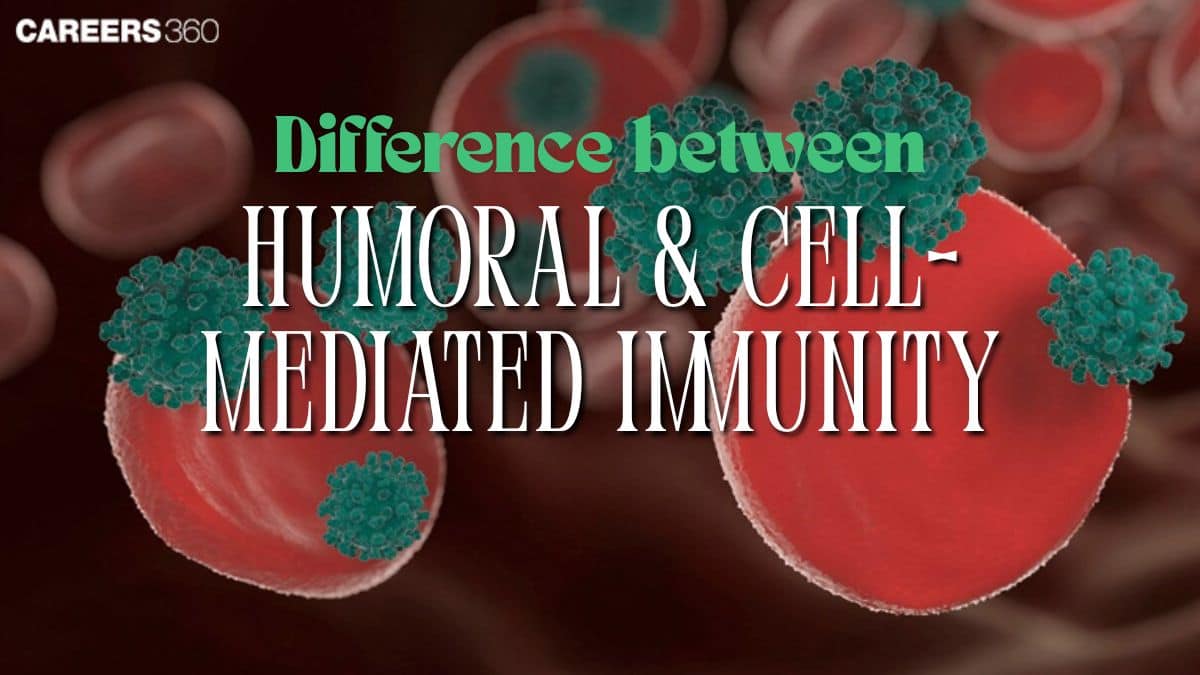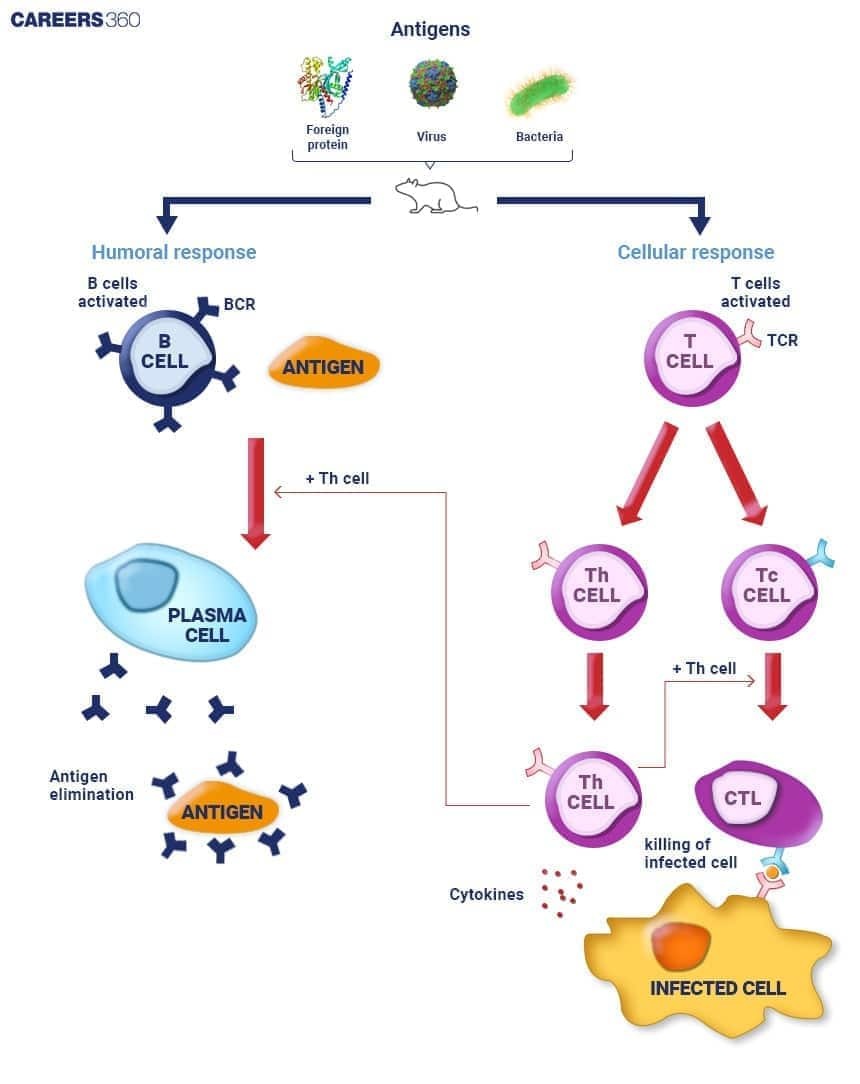Difference Between Humoral And Cell Mediated Immunity
The human immune system protects the body from pathogens through two main types of adaptive immune responses, humoral and cell-mediated immunity. They have distinct ways of defending the body. Humoral immunity involves B cells that produce antibodies to neutralize. Cell-mediated immunity, on the other hand, uses T cells to attack infected or abnormal cells directly. This distinction is important to understand how immunity and the immune system functions in various diseases.
This Story also Contains
- Humoral Immunity vs Cell-Mediated Immunity
- What is Humoral Immunity?
- What is Cell-Mediated Immunity?
- Humoral Immune Response vs Cell-Mediated Immune Response
- MCQs on Difference Between Humoral and Cell-Mediated Immunity

Recognizing the difference between humoral and cell-mediated immunity helps students understand how the body uses its defense based on the nature of the threat. It is important in antigen-antibody reaction, as these concepts explain how the immune system identifies, responds to, and remembers invading microorganisms. It is also essential for understanding topics like disease resistance, vaccination, and autoimmune disorders.
Humoral Immunity vs Cell-Mediated Immunity
The immune system is the body’s protection against infections and diseases. It is a cellular, tissue, and organ system capable of recognising and eliminating pathogens. Awareness of the immune system is essential, as it plays an important concept in human health and diseases. The two subdivisions of adaptive immunity include
Humoral immunity
Cell-mediated immunity
The key differences between humoral and cell-mediated immunity are:
Feature | Humoral Immunity | Cell-Mediated Immunity |
Definition | Immunity attributed to antibodies in body fluids | Immunity attributed by T cells |
Main Components | B cells, plasma cells, antibodies | T cells (helper, cytotoxic, regulatory) |
Target Pathogens | Extracellular pathogens (bacteria, viruses) | Intracellular pathogens (virus-infected cells) |
Mode of Action | Neutralisation, opsonisation, complement activation | Direct killing of infected cells |
Memory Cells | Memory B cells | Memory T cells |
Response Time | Faster response to pathogens | Slower response requires antigen presentation |
Duration of Response | Short to long-term, depending on memory cells | Long-term due to memory T cells |
Specificity | Specific to antigens but can bind to similar ones | Highly specific to presented antigens |
Examples of Responses | Response to bacterial diseases, neutralisation of toxins | Response to viral diseases, tumour cell destruction |
Primary Function | Protect against extracellular pathogens and toxins | Eliminate intracellular pathogens and abnormal cells |
Associated Disorders | Autoimmune diseases like lupus | Autoimmune diseases like multiple sclerosis |
Evolutionary Aspect | Present in all vertebrates | More specialised and complex, evolved in vertebrates |
What is Humoral Immunity?
Humoral Immunity is a kind of immunity produced by accessory cells known as antibodies that are released into the body fluids by B cells. It has the function of protecting the body against foreign microorganisms and removing toxins.
In this process, B cells are activated by the presence of antigens and, as a result, differentiate into plasma B cells and remember B cells. The antibodies specific to the antigens are produced by the plasma cells, while the memory B cells give a person immunity to the antigen in the long run.
Process of Humoral Response
B cells are efficient when an antigen invades the body because they identify it before attaching to it. They later turn into plasma cells that produce antibodies and memory B cells that ensure that response is hastened in the presence of a previous antigen.
Function of Antibodies
They inactivate the pathogens by binding to them, opsonize them, and call for the aid of the complement system to more easily dispose of the pathogens.
What is Cell-Mediated Immunity?
Cell-mediated immunity emphasises the T cells, which directly attack the cells that are infected or abnormal. It is useful for killing intracellular pathogens and cancer cells, the removal of which may cause problems for circulation.
Specific T cells distinguish between the cells of the body and infected ones. They are marked by foreign antigens on their surface, and kill them. Helper T cells are the common forms of T cells and help in the functioning of the other T cells, cytotoxic T cells that kill infected cells, regulatory T cells that suppress the immune response, and T memory cells that prolong the response to infection.
Types of T Cells
Different Types of Cell-mediated T-cells are described below:
Helper T cells (CD4+): They also help other immune cells that are involved in the immune response by producing what is known as cytokines.
Cytotoxic T cells (CD8+): To directly kill the infected or cancerous cells selectively the ability to identify the pathogenic organism or cancerous cell is required.
Regulatory T cells: Search for ways to ensure that the immune system does not attack the body’s tissues.
Memory T cells: Acquire long-term immunity by remembering past infections and provide long-term immunity.
Process of Cell-Mediated Response
T cells are activated by the process of presentation of the antigen. Cytotoxic T cells go on to eliminate the infected cells and on the other hand, helper T cells secrete cytokines facilitating the immune response.
Humoral Immune Response vs Cell-Mediated Immune Response
The humoral immune response involves B cells that produce antibodies to neutralize pathogens in body fluids like blood and lymph. It is effective against extracellular pathogens such as bacteria and viruses outside cells. In contrast, the cell-mediated immune response involves T cells that directly attack and destroy infected or abnormal cells. It is crucial for fighting intracellular infections and cancer cells. Both responses work together to provide complete immunity.

Similarities between Cell-mediated and Humoral Immunity
Major Similarities between Cell-Mediated and Humoral Immunity are discussed below in the table.
Aspect | Cell-mediated Immunity and Humoral Immunity | |
1. | Involvement of Lymphocytes | Both involve lymphocytes (B cells in humoral, T cells in cell-mediated) |
2. | Adaptive Immune Response | Both are part of the adaptive immune response |
3. | Antigen Specificity | Both are specific to particular antigens |
4. | Memory Cells Formation | Both generate memory cells for long-term immunity |
5. | Activation Requirement | Both require activation by antigens |
6. | Role in Immunity | Both are essential for effective immunity against pathogens |
7. | Involvement of Helper T Cells | Helper T cells assist in activating B cells |
8. | Interdependence | Cell-mediated immunity can influence humoral responses and Humoral immunity can influence cell-mediated responses |
MCQs on Difference Between Humoral and Cell-Mediated Immunity
Q1. Humoral immunity is associated with
T-cells
B-cells
Macrophages
Both 1 and 2
Correct answer: 2) B-cells
Explanation:
Humoral immunity, a crucial aspect of the adaptive immune system, is mainly characterized by the synthesis of antibodies, scientifically termed immunoglobulins, which are produced by B lymphocytes. These B cells, a specific category of white blood cells, are generated and fully developed in the bone marrow. Their primary function involves identifying distinct antigens, which are essentially foreign entities such as pathogens or toxins invading the body.
Role of Humoral Immunity:
Humoral immunity plays a crucial role in combating external pathogens, especially bacteria, early-stage viruses, and toxins that are present outside the body's cells. Moreover, it significantly contributes to the defense mechanism against infections caused by fungi and parasites.
Hence, the correct answer is option 2) B-cells.
Q2. Select the correct statement with respect to diseases and immunisation
Certain protozoans have been used to mass produce hepatitis B vaccine
Injection of snake antivenom against snake bite is an example of active immunisation
If due to some reason B-and T-lymphocytes are damaged, the body will not produce antibodies against a pathogen
Injection of dead / inactivated pathogens causes passive immunity
Correct answer: 3) If due to some reason B-and T-lymphocytes are damaged, the body will not produce antibodies against a pathogen
Explanation:
B- and T-lymphocytes are essential components of the immune system responsible for the production of antibodies and cellular immune responses. If these lymphocytes are damaged or not functioning properly, the body's ability to produce specific antibodies against pathogens will be compromised. This can result in a weakened immune response and increased susceptibility to infections.
Hence, the correct option is 3) If due to some reason B-and T-lymphocytes are damaged, the body will not produce antibodies against a pathogen.
Q3. Pathogen-specific immunity is
Humoral immunity
Acquired immunity
Innate immunity
Cell-mediated immunity
Correct answer: 2) Acquired immunity
Explanation:
Acquired immunity, otherwise referred to as adaptive or specific immunity, exhibits its pathogen-specific response. It is obtained postnatally and mediated by antibodies and lymphocytes working in concert to neutralize injurious antigens. The major characteristics include:
Specificity: This targets particular pathogens, so immunity can be focused on them.
Immunological Memory: First-time encounter by the immune system with a pathogen remembers and can rapidly mobilize a much-enhanced response at later encounters with it.
Diversity: The immune system can produce a variety of receptors to recognize diverse pathogens.
Self vs. Non-Self Discrimination It helps differentiate the body's self-cells from foreign invaders; otherwise, it would promote autoimmunity.
Hence, the correct answer is Option 2) Acquired immunity.
Also Read
Frequently Asked Questions (FAQs)
B cells are mainly associated with the immune response, which relies on the production of antibodies. B cells, when triggered by certain antigens, transform into plasma cells that secrete antibodies and memory B cells that confer immunological memory.
Cytotoxic T cells kill infected cells by binding to that cell via antigens that are present on the surface of the infected cell. They then neighbour and discharge perforins and granzymes into the infected cell, which forms pores in the cell membrane and kills the infected cell through apoptosis.
There are several functions that antibodies perform in humoral immunity. They inactivate pathogens since they form a complex with them, and they cannot go on and infect the cells. They also label the pathogens to be destroyed by the process called opsonization and stimulate the complement system, which increases the ability to eliminate pathogens from the body.
Yes, it is possible that both forms of immunity, such as humoral immunity and cell-mediated immunity, can be alike in an individual pathogen. For instance, during a viral disease, antibodies are capable of blocking the virus from spreading in the body fluids, while cytotoxic T cells can identify those cells that have been infected and kill them. Such a coordinated response helps to cover the whole territory of the organism against the pathogen.